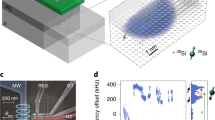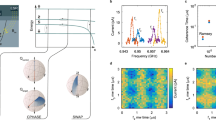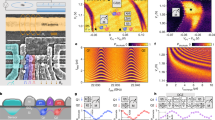Abstract
Quantum computation requires many qubits that can be coherently controlled and coupled to each other1. Qubits that are defined using lithographic techniques have been suggested to enable the development of scalable quantum systems because they can be implemented using semiconductor fabrication technology2,3,4,5. However, leading solid-state approaches function only at temperatures below 100 millikelvin, where cooling power is extremely limited, and this severely affects the prospects of practical quantum computation. Recent studies of electron spins in silicon have made progress towards a platform that can be operated at higher temperatures by demonstrating long spin lifetimes6, gate-based spin readout7 and coherent single-spin control8. However, a high-temperature two-qubit logic gate has not yet been demonstrated. Here we show that silicon quantum dots can have sufficient thermal robustness to enable the execution of a universal gate set at temperatures greater than one kelvin. We obtain single-qubit control via electron spin resonance and readout using Pauli spin blockade. In addition, we show individual coherent control of two qubits and measure single-qubit fidelities of up to 99.3 per cent. We demonstrate the tunability of the exchange interaction between the two spins from 0.5 to 18 megahertz and use it to execute coherent two-qubit controlled rotations. The demonstration of ‘hot’ and universal quantum logic in a semiconductor platform paves the way for quantum integrated circuits that host both the quantum hardware and its control circuitry on the same chip, providing a scalable approach towards practical quantum information processing.
This is a preview of subscription content, access via your institution
Access options
Access Nature and 54 other Nature Portfolio journals
Get Nature+, our best-value online-access subscription
$29.99 / 30 days
cancel any time
Subscribe to this journal
Receive 51 print issues and online access
$199.00 per year
only $3.90 per issue
Buy this article
- Purchase on Springer Link
- Instant access to full article PDF
Prices may be subject to local taxes which are calculated during checkout




Similar content being viewed by others
Data availability
All data underlying this study will become available on the 4TU ResearchData repository, https://doi.org/10.4121/uuid:22653416-85b0-4d7d-ad48-65967f9ea7ad.
References
Ladd, T. D., Jelezko, F., Laflamme, R., Nakamura, Y., Monroe, C. & O’Brien, J. L. Quantum computers. Nature 464, 45–53 (2010).
Vandersypen, L. M. K. et al. Interfacing spin qubits in quantum dots and donors—hot, dense, and coherent. npj Quant. Inf. 3, 34 (2017).
Veldhorst, M., Eenink, H. G. J., Yang, C. H. & Dzurak, A. S. Silicon CMOS architecture for a spin-based quantum computer. Nat. Commun. 8, 1766 (2017).
Devoret, M. H. & Schoelkopf, R. J. Superconducting circuits for quantum information: an outlook. Science 339, 1169–1174 (2013).
Neill, C. et al. A blueprint for demonstrating quantum supremacy with superconducting qubits. Science 360, 195–199 (2018).
Petit, L. et al. Spin lifetime and charge noise in hot silicon quantum dot qubits. Phys. Rev. Lett. 121, 076801 (2018).
Urdampilleta, M. et al. Gate-based high fidelity spin read-out in a CMOS device. Nat. Nanotechnol. 14, 737–741 (2019).
Yang, C. H. et al. Operation of a silicon quantum processor unit cell above one kelvin. Nature https://doi.org/10.1038/s41586-020-2171-6 (2019).
Loss, D. & DiVincenzo, D. P. Quantum computation with quantum dots. Phys. Rev. A 57, 120–126 (1998).
Zwanenburg, F. A. et al. Silicon quantum electronics. Rev. Mod. Phys. 85, 961–1019 (2013).
Veldhorst, M. et al. An addressable quantum dot qubit with fault-tolerant control-fidelity. Nat. Nanotechnol. 9, 981–985 (2014).
Itoh, K. M. & Watanabe, H. Isotope engineering of silicon and diamond for quantum computing and sensing applications. MRS Commun. 4, 143–157 (2014).
Yoneda, J. et al. A quantum-dot spin qubit with coherence limited by charge noise and fidelity higher than 99.9%. Nat. Nanotechnol. 13, 102–106 (2018).
Yang, C. H. et al. Silicon qubit fidelities approaching incoherent noise limits via pulse engineering. Nat. Electron. 2, 151–158 (2019).
Veldhorst, M. et al. A two-qubit logic gate in silicon. Nature 526, 410–414 (2015).
Zajac, D. M. et al. Resonantly driven CNOT gate for electron spins. Science 359, 439–442 (2018).
Watson, T. F. et al. A programmable two-qubit quantum processor in silicon. Nature 555, 633–637 (2018).
Huang, W. et al. Fidelity benchmarks for two-qubit gates in silicon. Nature 569, 532–536 (2019).
Fowler, A. G., Mariantoni, M., Martinis, J. M. & Cleland A. N. Surface codes: towards practical large-scale quantum computation. Phys. Rev. A 86, 032324 (2012).
Franke, D. P., Clarke, J. S., Vandersypen, L. M. K. & Veldhorst, M. Rent’s rule and extensibility in quantum computing. Microprocess. Microsyst. 67, 1–7 (2019).
Li, R. et al. A crossbar network for silicon quantum dot qubits. Sci. Adv. 4, eaar3960 (2018).
Lawrie, W. I. L. et al. Quantum dot arrays in silicon and germanium. Appl. Phys. Lett. 116, 080501 (2020).
Angus, S. J., Ferguson, A. J., Dzurak, A. S. & Clark, R. G. Gate-defined quantum dots in intrinsic silicon. Nano Lett. 7, 2051–2055 (2007).
Morello, A. et al. Single-shot readout of an electron spin in silicon. Nature 467, 687–691 (2010).
Elzerman, J. M., Hanson, R., Van Beveren, L. W., Witkamp, B., Vandersypen, L. M. K. & Kouwenhoven, L. P. Single-shot read-out of an individual electron spin in a quantum dot. Nature 430, 431–435 (2004).
Yang, C. H. et al. Spin-valley lifetimes in a silicon quantum dot with tunable valley splitting. Nat. Commun. 4, 2069 (2013).
Ruskov, R., Veldhorst, M., Dzurak A. S. & Tahan, C. Electron g-factor of valley states in realistic silicon quantum dots. Phys. Rev. B 98, 245424 (2018).
Magesan, E., Gambetta, J. M. & Emerson, J. Scalable and robust randomized benchmarking of quantum processes. Phys. Rev. Lett. 106, 180504 (2011).
Reed, M. D. et al. Reduced sensitivity to charge noise in semiconductor spin qubits via symmetric operation. Phys. Rev. Lett. 116, 110402 (2016).
Martins, F. et al. Noise suppression using symmetric exchange gates in spin qubits. Phys. Rev. Lett. 116, 116801 (2016).
Güngördü, U. & Kestner, J. P. Pulse sequence designed for robust C-phase gates in SiMOS and Si/SiGe double quantum dots. Phys. Rev. B 98, 165301 (2018).
Freeman, B. M., Schoenfield, J. S. and Jiang, H. Comparison of low frequency charge noise in identically patterned Si/SiO2 and Si/SiGe quantum dots. Appl. Phys. Lett. 108, 253108 (2016).
Paladino, E., Galperin, Y. M., Falci, G. & Altshuler, B. L. 1/f noise: implications for solid-state quantum information. Rev. Mod. Phys. 86, 361–418 (2014).
Connors, E. J., Nelson, J. J., Qiao, H., Edge, L. F. & Nichol, J. M. Low-frequency charge noise in Si/SiGe quantum dots. Phys. Rev. B 100, 165305 (2019).
Yang, C. H., Lim, W. H., Zwanenburg, F. A. & Dzurak, A. S. Dynamically controlled charge sensing of a few-electron silicon quantum dot. AIP Adv. 1, 042111 (2011).
Eenink, H. G. J. et al. Tunable coupling and isolation of single electrons in silicon metal-oxide-semiconductor quantum dots. Nano Lett. 19, 8653–8657 (2019).
Acknowledgements
We thank J. Helsen for developing the code for the compilation of the two-qubit Clifford group. We additionally thank M. Mehmandoost and V. V. Dobrovitski for discussions and suggestions. L.P., H.G.J.E. and M.V. are funded by a Netherlands Organization of Scientific Research (NWO) VIDI grant. Research was sponsored by the US Army Research Office (ARO) and was accomplished under grant number W911NF-17-1-0274. The views and conclusions contained in this document are those of the authors and should not be interpreted as representing the official policies, either expressed or implied, of the Army Research Office (ARO), or the US Government. The US Government is authorized to reproduce and distribute reprints for Government purposes notwithstanding any copyright notation herein.
Author information
Authors and Affiliations
Contributions
L.P. and H.G.J.E. performed the experiment. H.G.J.E. fabricated the device. W.I.L.L. contributed to the process development; N.W.H. and S.G.J.P. contributed to the preparation of the experiment. J.S.C. supervised the wafer growth. L.P. and M.R. analysed the results with input from all authors. L.M.K.V. and M.V. conceived the project. L.P. and M.V. wrote the manuscript with input from all authors. M.V. supervised the project.
Corresponding author
Ethics declarations
Competing interests
The authors declare no competing interests.
Additional information
Peer review information Nature thanks HongWen Jiang and the other, anonymous, reviewer(s) for their contribution to the peer review of this work.
Publisher’s note Springer Nature remains neutral with regard to jurisdictional claims in published maps and institutional affiliations.
Extended data figures and tables
Extended Data Fig. 1 Charge readout and visibility.
a, Histograms of the readout signal for the singlet and triplet state for two operating temperatures. The sensitivity is reduced at higher temperatures, mainly because of the thermal broadening of the Coulomb peaks. The readout signal is obtained by subtracting a reference line obtained from a sequence with no microwave pulse applied. The integration time corresponds to 40 μs. The readout fidelity may be improved by optimizing the charge sensing36 and by using a radiofrequency reflectometry or dispersive measurement scheme, as shown in ref. 7. b, Rabi oscillations of Q1 (see also Fig. 2b), obtained by assigning the state spin-up or spin-down to each single-shot trace, by using a threshold obtained from the histograms in a. From the data we can extract the visibility, which we find to be V ≈ 0.2 at T = 1.1 K.
Extended Data Fig. 2 Spin-to-charge conversion.
a, Normalized probability of detecting the four two-electron spin states as a triplet state (U, spin up; D, spin down). The probability that the triplet antiparallel spin state is correctly identified as a triplet can be reduced by the non-perfect adiabaticity of the pulse and by a faster triplet–singlet relaxation.
Extended Data Fig. 3 Exchange interaction.
a, b, Resonance frequency of both qubits as a function of the detuning energy. a, Transitions f1 and f4. b, Transitions f2 and f3. We measure the excited states by ESR-controlled spin flips applied to the control qubit.
Extended Data Fig. 4 Relaxation times.
a, b, Single-spin relaxation times of Q1 and Q2. The measurements are performed by fitting the decay of the states |⇵⟩ and |⇅⟩ to state |⇊⟩. We extract T1(Q1) = 2.0 ms and T1(Q2) = 3.7 ms, consistent with ref. 6. Triplet probabilities have been normalized to remove readout errors.
Extended Data Fig. 5 Time dependence of the resonance frequencies and the readout point.
a, Time dependence of the resonance frequencies f1 and f4 of Q1 and Q2, respectively. The exchange interaction is set to 2.5 MHz. The data have been offset by 6.9491 GHz and 6.9620 GHz for f1 and f4, respectively. b, Time dependence of the readout point obtained by sweeping along the detuning axis in a measurement identical to the one shown in Fig. 1d. The best readout point is achieved with a Gaussian fit of the visibility peak.
Extended Data Fig. 6 Dephasing times for Q1 and Q2 as a function of exchange interaction.
a, Dephasing times of Q1 and Q2 as a function of exchange interaction, fitted with the model discussed in Supplementary Information section II. Because of the different tuning configuration, the dephasing times are slightly longer than the ones reported in the main text. In this configuration, we measure a tunnel couping of tc = 0.8 GHz and a Zeeman energy difference of δEZ = 10.6 MHz. Error bars are 1 s.d. from the mean.
Supplementary information
Supplementary Information
This file contains: I. Fit of the full exchange spectrum; II. Noise model and noise fitting; and III. Temperature dependence of the dephasing time; and additional references.
Rights and permissions
About this article
Cite this article
Petit, L., Eenink, H.G.J., Russ, M. et al. Universal quantum logic in hot silicon qubits. Nature 580, 355–359 (2020). https://doi.org/10.1038/s41586-020-2170-7
Received:
Accepted:
Published:
Issue Date:
DOI: https://doi.org/10.1038/s41586-020-2170-7
This article is cited by
-
Hamiltonian phase error in resonantly driven CNOT gate above the fault-tolerant threshold
npj Quantum Information (2024)
-
Non-symmetric Pauli spin blockade in a silicon double quantum dot
npj Quantum Information (2024)
-
High temperature spin selectivity in a quantum dot qubit using reservoir spin accumulation
npj Quantum Information (2024)
-
Coherent control of enhanced second-harmonic generation in a plasmonic nanocircuit using a transition metal dichalcogenide monolayer
Nature Communications (2024)
-
High-fidelity spin qubit operation and algorithmic initialization above 1 K
Nature (2024)
Comments
By submitting a comment you agree to abide by our Terms and Community Guidelines. If you find something abusive or that does not comply with our terms or guidelines please flag it as inappropriate.



